

Can 'Minecraft' Really Change the Way Teachers Teach? To call Minecraft anything less than a phenomenon would be an understatement.

Since releasing in 2009, it has sold more than a hundred million copies across almost every gaming platform and continues to sell another 50,000 more each day. Among children anywhere from toddlers to young adults, Minecraft is especially popular, so it's no surprise that it has seeped its way into more than a few classrooms through teachers looking to build a sturdier bridge to their students. Earlier this year, Microsoft announced an official investment in bringing Minecraft to the classroom in the form of Minecraft: Education Edition, a reimagining of Minecraft with additional tools aimed at educators. And on June 9, Education Edition was launched as a free early access version aimed at giving teachers time to prepare to use Minecraft in the classroom this fall. Minecraft: Education Edition is, what Microsoft hopes, the tool that educators need to reach a modern generation of students.
3 Gamification Examples That Make Corporate Learning Fun. The Minecraft Generation. In its first year, Minecraft found popularity mostly among adult nerds.
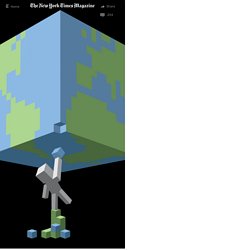
But sometime in late 2011, according to Alex Leavitt, a Ph.D. candidate at the University of Southern California, children discovered it, and sales of the game exploded. Today it costs $27 and sells 10,000 copies a day. (It’s still popular across all age groups; according to Microsoft, the average player is between 28 and 29, and women make up nearly 40 percent of all players.) Report: Game-Based Learning Helps Students Develop Writing Skills. Research Report: Game-Based Learning Helps Students Develop Writing Skills According to initial results from recent pilot, digital game-based learning improved student engagement and self-efficacy in writing courses at 14 colleges and universities.
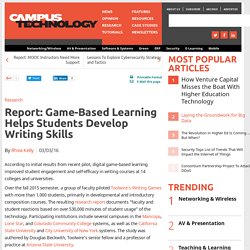
Can students learn the Common Core through gaming? Teachers are increasingly turning to video games to enhance their students’ learning, but in the age of the Common Core, not all games are created equally.
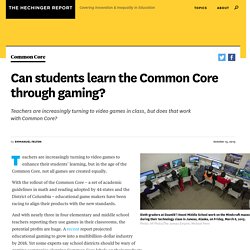
With the rollout of the Common Core – a set of academic guidelines in math and reading adopted by 44 states and the District of Columbia – educational game makers have been racing to align their products with the new standards. And with nearly three in four elementary and middle school teachers reporting they use games in their classrooms, the potential profits are huge. A recent report projected educational gaming to grow into a multibillion-dollar industry by 2018. Positive Effects of Mobile Gaming in the Classroom. When it comes to improving learning outcomes in classrooms, teachers will go to great lengths and explore all possible avenues.
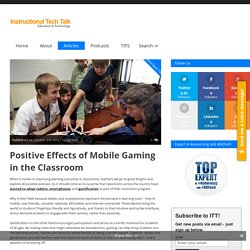
So it should come as no surprise that classrooms across the country have started to adopt tablets, smartphones, and gamification as part of their curriculum program. Why is this? Well, because tablets and smartphones represent the pinnacle in learning tools – they’re mobile, user-friendly, versatile, relatively affordable, and Internet-connected. Ideas for Using Minecraft in the Classroom. As is the nature of sandbox games, players can roam free, choosing objectives as they go.
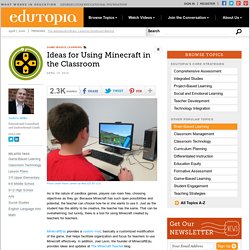
Because Minecraft has such open possibilities and potential, the teacher can choose how he or she wants to use it. Just as the student has the ability to be creative, the teacher has the same. That can be overwhelming, but luckily, there is a tool for using Minecraft created by teachers for teachers. MinecraftEdu provides a custom mod, basically a customized modification of the game, that helps facilitate organization and focus for teachers to use Minecraft effectively. In addition, Joel Levin, the founder of MinecraftEdu, provides ideas and updates at The Minecraft Teacher blog. What does it mean to have your whole middle-school curriculum designed around games? The Mac Lab. Minecraft Resources for Teachers on Flipboard. Jenn de la Vega / July 28, 2015 The game Minecraft is an emerging way to teach and learn basic concepts of collaboration in the classroom.
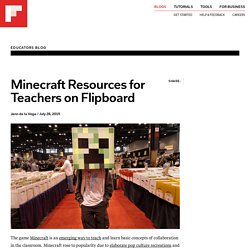
Leveling Up: Why Gamers Make Better Learners - eLearning Mind. Hours spent alone with your Xbox might not be the same as hours spent in the library, but–contrary to your mom’s belief–your dedication to Modern Warfare isn’t for naught.
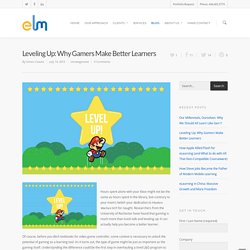
Researchers from the University of Rochester have found that gaming is much more than trash talk and leveling up: It can actually help you become a better learner. Mixing Minecraft and California History. Future of History guest contributor David Goldberg teaches with Jody Passanisi at a K-8 independent school in Los Angeles.
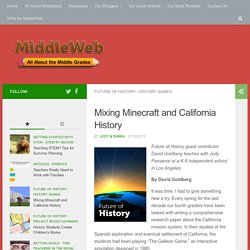
By David Goldberg It was time. I had to give something new a try. Minecraft in school? How video games could be the future of learning. Why Video Games Like Mario Kart and World of Warcraft Could Be Making Their Way Into Classrooms. Paul Cross has a resume that many high-school students today would probably salivate over.
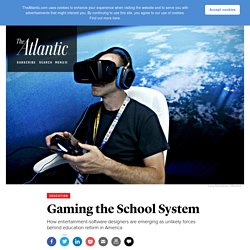
When he was the lead designer at Criterion Games, he developed a series of high-speed racing games called Burnout. He also served as a consultant for the powerhouse game company Electronic Arts, helping it develop its first-person shooter game Medal of Honor. Now he’s the director of game design at Ubisoft Entertainment, the multinational video-game developer responsible for titles such as Assassin’s Creed, Just Dance, and Rocksmith—the hugely popular game he created that teaches players real songs on the electric guitar. Why Gaming Matters for Education. This is the first of a series of articles on the use of games in education. Why a series on edugames? 1. Gaming is ubiquitous. 2. Games combine effective pedagogy, high engagement, and assessment. Things to remember when combining Gamification with mLearning.
Gamification is a much talked about topic these days. By the end of 2014, over 70% of the 2000 largest companies have deployed at least a single gamified application. An estimated $5.5 million is expected to be generated by the overall market for gamification tools, applications, and services. Gamify Student Learning with Common Core Quest. Three ways to use Minecraft imaginatively in the classroom. The MindShift Guide to Digital Games and Learning. MindShift Guide to Digital Games and Learning. Gamify Student Learning with Common Core Quest. Do Kids Really Learn From Playing Educational Games on Tablets? The Myth of the Minecraft Curriculum. In reality, the computer program "has about as much inherent educational value as an overhead projector. " Everyone loves to talk about how Minecraft, the popular computer game where players build structures out of blocks, is educational. Ed Games Need To Fill in Assessment Gaps To Be Fully Useful.
Gaming. Beyond Programming: The Power of Making Games. Gaming Beyond Programming: The Power of Making Games. DUST. Tag Team Tech: Wrestling with Teens and Technology June 2014. TaleBlazer. When educational games work: Mission U.S. demonstrates best of video game learning. Sixth graders ditch traditional lessons to create video game businesses. 3 Ways Coding and Gaming Can Enhance Learning. Ideas for Using Minecraft in the Classroom.
How do we harness the power of games? SmartBlogs. Let the Games Begin: Students and Teachers Dive Into SimCityEDU. How Video Games Are Getting Inside Your Head — And Wallet : All Tech Considered.